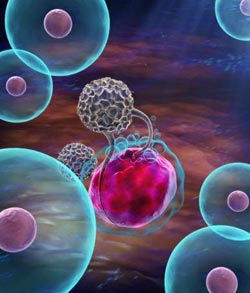Immune system marker tied to improved bone marrow transplant outcomes

The new screening approach developed by St. Jude involves identifying donors who make the most potent version of specialized immune cells called natural killer (NK) cells. Illustrated is an NK cell destroying a cancer cell.<br><br>Credit: Joshua Stokes, St. Jude Children's Research Hospital<br>
The risk of death following bone marrow transplantation can be reduced about 60 percent using a new technique to identify bone marrow donors who make the most potent cancer-fighting immune cells, according to research from St. Jude Children's Research Hospital. The findings appear in the September 16 online issue of the Journal of Clinical Oncology.
The research builds on an earlier St. Jude discovery that specialized immune cells called natural killer (NK) cells dispatched cancer cells more efficiently when the NK cells carried a particular version of a KIR protein on their surface. KIR is short for killer-cell immunoglobulin-like receptor. KIR proteins regulate NK cells.
For this study, researchers reviewed the outcomes of the 313 bone marrow transplants performed at St. Jude during the decade ending in January 2010. Investigators found that patients were far more likely to have survived the transplant and far less likely to have their disease progress if their new bone marrow came from donors whose NK cells included the same version of the protein, rather than the alternative form.
“This approach should dramatically improve the outcome for patients undergoing bone marrow transplantation, regardless of their age or underlying condition,” said Wing Leung, M.D., Ph.D., the paper's corresponding author and chair of the St. Jude Department of Bone Marrow Transplantation and Cellular Therapy. “NK cells also play an important role in autoimmune disorders, chronic infections and other conditions, so these results will likely have an impact beyond cancer.”
Transplant patients benefited regardless of their disease, previous treatment, completeness of the genetic match or other donor characteristics, including whether the donor was a relative, Leung said. Screening for the NK cell variation uses blood collected for the current donor screening process and will not slow donor selection.
NK cells account for less than 15 percent of white blood cells, but play a major role in defending against cancer and viral infections. This research focused on a protein named KIR2DL1, which belongs to the KIR family of proteins. The KIR2DL1 protein is found on NK cells of nearly all healthy individuals.
Proteins are made up of long chains of amino acids. Due to natural genetic variation, there are 25 versions of KIR2DL1, each with a slightly different amino acid sequence.
In an earlier study, Leung and his colleagues discovered that NK cells with one of the KIR2DL1 variations killed cancer cells growing in the laboratory more efficiently than NK cells with a different version of the protein. The potent NK cells featured the amino acid arginine at position 245 of KIR2DL1 rather than the amino acid cysteine in that spot. That discovery led to this study, which offers the first proof that the amino acid difference impacts patient outcomes.
Researchers checked the outcomes of all bone marrow transplants performed at St. Jude during the 10-year period. They found that donor bone marrow with two copies of the gene for the arginine 245 version of KIR2DL1 was associated with a 60 percent decreased risk of death following transplantation and a 62 percent reduced risk of disease progression compared to transplants with donor bone marrow that carried instructions for making just the cysteine version. The transplants involved patients battling both acute lymphoblastic and acute myeloid leukemia as well as other conditions.
St. Jude has patented and licensed a test to identify potential donors with the preferred amino acid. The goal is to make the screening test widely available to other transplant centers as soon as possible, officials said.
The study's first authors are Rafijul Bari of St. Jude and Piya Rujkijyanont, formerly of St. Jude. The other authors are Erin Sullivan, Guolian Kang, Victoria Turner and Kwan Gan, all of St. Jude.
The research was supported in part by grants (CA02176524 and CA021765) from the National Institutes of Health, the Assisi Foundation of Memphis and ALSAC.
Media Contact
More Information:
http://www.stjude.orgAll latest news from the category: Health and Medicine
This subject area encompasses research and studies in the field of human medicine.
Among the wide-ranging list of topics covered here are anesthesiology, anatomy, surgery, human genetics, hygiene and environmental medicine, internal medicine, neurology, pharmacology, physiology, urology and dental medicine.
Newest articles

Silicon Carbide Innovation Alliance to drive industrial-scale semiconductor work
Known for its ability to withstand extreme environments and high voltages, silicon carbide (SiC) is a semiconducting material made up of silicon and carbon atoms arranged into crystals that is…

New SPECT/CT technique shows impressive biomarker identification
…offers increased access for prostate cancer patients. A novel SPECT/CT acquisition method can accurately detect radiopharmaceutical biodistribution in a convenient manner for prostate cancer patients, opening the door for more…

How 3D printers can give robots a soft touch
Soft skin coverings and touch sensors have emerged as a promising feature for robots that are both safer and more intuitive for human interaction, but they are expensive and difficult…





















